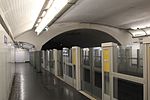Agoudas Hakehilos Synagogue
1914 establishments in FranceArt Nouveau architecture in ParisArt Nouveau synagoguesAshkenazi Jewish culture in FranceBuildings and structures in the 4th arrondissement of Paris ... and 9 more
Le MaraisMonuments historiques of ParisOrthodox synagogues in FrancePolish diaspora in EuropeRussian-Jewish diaspora in EuropeRussian diaspora in FranceSynagogues completed in 1914Synagogues in ParisWorks by Hector Guimard

The Agoudas Hakehilos Synagogue (אֲגֻדָּת־הַקְּהִלּוֹת, Union of the communities), at 10 rue Pavée, in the 4th arrondissement of Paris (Le Marais quarter), commonly referred to at the Pavée synagogue, rue Pavée synagogue, or Guimard synagogue, was designed by Art Nouveau architect Hector Guimard and erected between 1913 and 1914.
Excerpt from the Wikipedia article Agoudas Hakehilos Synagogue (License: CC BY-SA 3.0, Authors, Images).Agoudas Hakehilos Synagogue
Rue Pavée, Paris 4th Arrondissement (Paris)
Geographical coordinates (GPS) Address External links Nearby Places Show on map
Geographical coordinates (GPS)
| Latitude | Longitude |
|---|---|
| N 48.855972222222 ° | E 2.3604861111111 ° |
Address
Synagogue
Rue Pavée
75004 Paris, 4th Arrondissement (Paris)
Ile-de-France, France
Open on Google Maps











